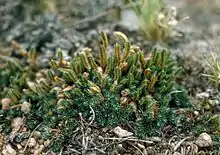Selaginella densa
Selaginella densa is a species of spikemoss known by the common names lesser spikemoss,[1] prairie spikemoss, and Rocky Mountains spikemoss. It is native to western North America, where it can be found from Alaska to Ontario, the Dakotas, Texas and far northern California.
| Selaginella densa | |
|---|---|
 | |
| Scientific classification | |
| Kingdom: | Plantae |
| Clade: | Tracheophytes |
| Clade: | Lycophytes |
| Class: | Lycopodiopsida |
| Order: | Selaginellales |
| Family: | Selaginellaceae |
| Genus: | Selaginella |
| Species: | S. densa |
| Binomial name | |
| Selaginella densa | |
It grows in many types of habitat, from grassland to the alpine climates of high mountains, in rocky and sandy areas. It is a dominant plant in many types of prairie on the Great Plains, especially shortgrass prairie, where it grows alongside dominant grasses.[2] It grows in windy, exposed, snow-free rock outcrops on mountain peaks in several ranges, including the Cascade Range and the Front Range of the Rocky Mountains.[2] It is most common on dry soils in open areas, tolerating desiccation relatively easily.[2]
This lycophyte forms mats or cushions of creeping stems which fork into small, upright branches. The green, linear or lance-shaped leaves are up to 5 millimeters long including the short, soft bristles on the tips. They are flattened to the stem. The strobili at the ends of the stems can be up to 3 or 4 centimeters long.
This compact groundcover plant protects the soil from erosion and can be used in landscaping for that purpose.[2]
References
- USDA, NRCS (n.d.). "Selaginella densa". The PLANTS Database (plants.usda.gov). Greensboro, North Carolina: National Plant Data Team. Retrieved 9 November 2015.
- US Forest Service Fire Ecology
